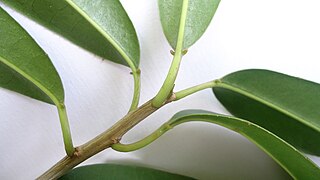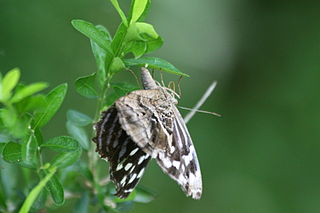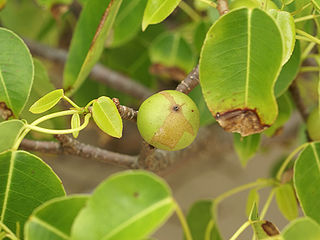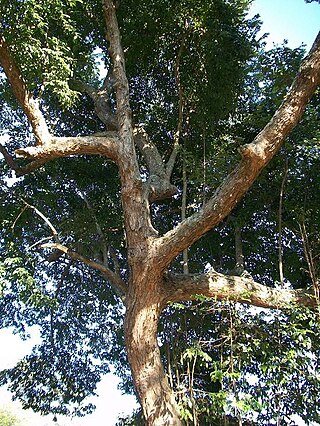
Sapium is a genus of flowering plants in the family Euphorbiaceae. It is widespread across most of Latin America and the West Indies. Many Old World species were formerly included in the genus, but recent authors have redistributed all the Old World species into other genera.

Amanoa is a genus from the family Phyllanthaceae first described as a genus in 1775. It is native to South America, Central America, the West Indies, and tropical Africa.

Pera is a genus of plants in the family Peraceae native to tropical America, from southern Mexico and the West Indies south as far as Paraguay. It first described as a genus in 1784.

Cnidoscolus is a plant genus of the family Euphorbiaceae first described as a genus in 1827. The group is widespread across much of North and South America, including the West Indies.

Adelia is a genus of flowering plants in the spurge family, Euphorbiaceae, subfamily Acalyphoideae. It is native to Latin America and the Caribbean, with one species extending northward into the southernmost part of Texas.
Bernardia is a plant genus of the family Euphorbiaceae first described for modern science as a genus in 1754. It is native to North and South America, as well as the West Indies.

Chaetocarpus is a plant genus of the family Peraceae, formerly Euphorbiaceae, first described as a genus in 1854. Chaetocarpus species are trees or shrubs. They are native to the Americas, Africa, and Asia. Some species are endangered.
- Chaetocarpus acutifolius(Britton & P.Wilson) Borhidi – Sierra de Moa in Cuba
- Chaetocarpus africanusPax – C Africa
- Chaetocarpus castanocarpus(Roxb.) Thwaites – SE Asia, Yunnan, Assam, Bangladesh, Sri Lanka
- Chaetocarpus cordifolius(Urb.) Borhidi – Cuba, Hispaniola, Jamaica
- Chaetocarpus coriaceusThwaites – Sri Lanka
- Chaetocarpus cubensisFawc. & Rendle – Cuba
- Chaetocarpus echinocarpus (Baill.) Ducke – Bolivia, Brazil
- Chaetocarpus ferrugineusPhilcox – Sri Lanka
- Chaetocarpus gabonensisBreteler – Gabon
- Chaetocarpus globosus(Sw.) Fawc. & Rendle – Jamaica, Cuba, Dominican Rep.
- Chaetocarpus myrsinitesBaill. – Bolivia, Brazil
- Chaetocarpus parvifoliusBorhidi – Cuba
- Chaetocarpus pearceiRusby – Bolivia
- Chaetocarpus pubescens(Thwaites) Hook.f. – Sri Lanka
- Chaetocarpus rabarabaCapuron – Madagascar
- Chaetocarpus schomburgkianus(Kuntze) Pax & K.Hoffm. – Colombia, Venezuela, 3 Guianas, NW Brazil

Caperonia is a genus of plants of the family Euphorbiaceae first described as a genus in 1825. The genus is native to tropical and subtropical America and Africa.

Ditaxis is a plant genus of the family Euphorbiaceae first described as a genus in 1824. Its name comes from Greek dis ("two") and taxis ("rank"), referring to the stamens which are in two whorls. The genus is widespread across much of the Western Hemisphere from the southern United States to Uruguay.

Acidoton is a genus of plant of the family Euphorbiaceae first described as a genus in 1788. It is native to the Greater Antilles, Central America, and tropical South America.
Ophellantha is a genus of plants under the family Euphorbiaceae first described as a genus in 1924. It is native to southern Mexico and northern Central America.
- Ophellantha spinosaStandl. - Honduras, El Salvador, Chiapas, Veracruz
- Ophellantha steyermarkiiStandl. - Guatemala, Chiapas

Gymnanthes is a genus of flowering plants in the spurge family, Euphorbiaceae, first described as a genus in 1788. It is found primarily in the warmer parts of the Western Hemisphere, but with some species in central Africa and southwestern Southeast Asia.

Hippomane is a genus of plants in the Euphorbiaceae described by Linnaeus in 1753. It is native to the West Indies, Central America, Mexico, Florida, Venezuela, Colombia, and Galápagos.

Hieronyma is a genus in the plant family Phyllanthaceae. It was first described as a genus in 1848. This family was formerly united with spurges, crotons, copperleaves, etc. (Euphorbiaceae), but have turned out to be well distinct. The genus is native to South America, Central America, southern Mexico, and the West Indies. It is dioecious, with male and female flowers on separate plants.
Astrocasia is a plant genus of the family Phyllanthaceae first described as a genus in 1905. It is included in the subtribe Astrocasiinae. It is native to Mesoamerica, northern South America, and the western part of the West Indies. Plants are mostly dioecious, except for Astrocasia diegoae which is monoecious, and some individuals of A. neurocarpa and A. tremula.
- Astrocasia austinii(Standl.) G.L.Webster - Izabal
- Astrocasia diegoaeJ.Jiménez Ram. & Mart.Gord. - Guerrero
- Astrocasia jacobinensis(Müll.Arg.) G.L.Webster - Bahia, Bolivia
- Astrocasia neurocarpa(Müll.Arg.) I.M.Johnst. ex Standl. - Oaxaca, Querétaro, San Luis Potosí, Tamaulipas
- Astrocasia peltataStandl. - Costa Rica, Nayarit, Jalisco
- Astrocasia tremula (Griseb.) G.L.Webster - Mexico, Central America, West Indies, northern South America

Margaritaria is a plant genus of the family Phyllanthaceae first published as a genus in 1782. It is the smallest pantropical genus of the Phyllanthaceae and, formerly, of the Euphorbiaceae, widely distributed in tropical and subtropical regions of Asia, Africa, Australia, North and South America, and various oceanic islands.

Koanophyllon is a genus of plants in the family Asteraceae. They are perennials and shrubs and are native to South America, Central America, the West Indies, Mexico, with a few species range extending into the United States. The flowers are white to pinkish.

Citharexylum is a genus of flowering plants in the verbena family, Verbenaceae. It contains shrub and tree species commonly known as fiddlewoods or zitherwoods. They are native to the Americas, ranging from southern Florida and Texas in the United States to Argentina. The highest diversity occurs in Mexico and the Andes. The generic name is derived from the Greek words κιθάρα (kithara), meaning "lyre", and ξύλον (xylon), meaning "wood," referring to the use of the wood in the sounding boards of string instruments. Several species, especially C. caudatum and C. spinosum, are cultivated as ornamentals.

Exophthalmus is a genus of broad-nosed weevils in the family Curculionidae. It contains 85 described species.
















